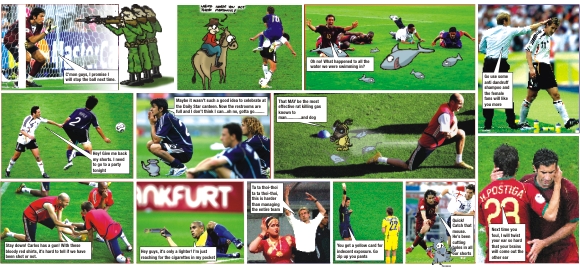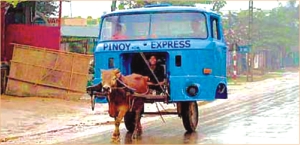Scenes unseen:Exclusive Footballt W orld Cup Scenes that you were not meant to see
By Ronny, Shiplu and the peeing dog

Sci-Stuff
By Ziad
Computer age produces new social system
Apparently pirating your music files is leading to the emergence of a new social system. A Canadian scientist says members of peer-to-peer file sharing networks, like the early users of Napster, are part of a previously unseen social system. "Everything that is crucial to establishing a system of social solidarity through gift giving -- social distinctions, norm of reciprocity, and rituals and symbolisms -- could also be found in the consumption activities of Napster users," said Markus Giesler of the Schulich School of Business at York University in Toronto. As traditional social systems, self-imposed rules emerge in the process of downloading and uploading files, and symbolisms appear in the usernames people choose, said Giesler. Members of online file-sharing communities also adhere to a norm of reciprocity -- that is, they must share music if they want to receive any. "One of the most interesting conceptual take-aways of this research is that social solidarity is not only to be found in  the classic and often romanticized social organs of family, neighborhood, or church community," said Giesler. The research appears in the Journal of Consumer Research.
the classic and often romanticized social organs of family, neighborhood, or church community," said Giesler. The research appears in the Journal of Consumer Research.
Digital camera blocking technology created
Georgia Institute of Technology scientists say they've created a prototype device that can block digital video cameras from working in a specific area. The scientists say the prototype -- which could be used to stymie unwanted use of video or still cameras -- uses off-the-shelf equipment to scan for, find and neutralize digital cameras. The system works by looking for the reflectivity and shape of the image-producing sensors used in digital cameras. Associate GIT Professor Gregory Abowd, who led the study, says the camera-neutralizing technology shows commercial promise in two principal fields -- protecting areas against espionage photography and stopping video copying.
Researchers explain a digital camera's image sensor -- called a CCD -- sends light back directly to its origin rather than scattering it, making it relatively easy to detect and identify video cameras. Once a scanning laser and photo-detector located a video camera, the system would flash a thin beam of visible white light directly at the CCD, overwhelming the target camera with light and rendering recorded video unusable. A paper on the technology, which is still under development, was presented during the Ubicomp conference in Tokyo last September.
Expect celebrities to buy these gizmos by the truckloads. Sad news for voyeurs though.
Human activities can affect rainfall
It seems dancing for rain may not be such a bad idea after all. U.S. researchers say they've determined human activities in arid urban environments can affect the rainfall and water cycle. While scientists have known for some time the so-called "heat- island" effect of large cities can affect weather, they knew less about that effect and other processes in arid cities, such as Phoenix, that have experienced explosive population growth. Now, a study by Marshall Shepherd, a climatologist at the University of Georgia, has shown -- using a unique 108-year-old data record and NASA's Tropical Rainfall Measuring Mission satellite -- arid cities such as Riyadh in Saudi Arabia and Phoenix have an effect on rainfall patterns around them. The study showed a 2-percent increase in rainfall in Phoenix, but researchers said that could be an anomaly. As important, it appears human activities such as land use, aerosols and irrigation in these arid urban environments affect the entire water cycle as well. "Many of the fastest-growing urban areas are in arid regimes," said Shepherd. The research appears in the online edition of the Journal of Arid Environments.
Doomsday vault under construction
It sounds like a 1950s science fiction movie plot, but five Nordic nations say they are building a "doomsday seed vault" in an Arctic mountain. The vault, being built near Svalbard, Norway, on a Barents Sea island, is designed to ensure the long- term survival of the Earth's food crops should a major catastrophe befall the planet, Global Crop Diversity Trust said in a release. Three feet of reinforced concrete will fortify the seed repository of last resort, with Arctic permafrost keeping samples frozen for 100 years, even if electricity fails, officials said. The samples -- stored in watertight foil packages -- will be protected by massive security doors, guards, motion detectors and even the ubiquitous presence of polar bears. The $3 million vault will have a capacity of 3 million seed samples -- replicates of the world's most critical crop collections, now scattered among some 1,400 gene banks on every continent except Antarctica. Samples will remain viable for hundreds of years -- some varieties for thousands of years -- and will only be released in the event all other seed sources have been destroyed or exhausted. Construction began Monday with a ceremony attended by the prime ministers of Denmark, Finland, Iceland, Norway and Sweden.
Now, I can't seem to help wondering how al that money, effort and brain power could be better used in preventing Doomsday in the first place.
U.S. cars among world's worst polluters
U.S. cars and pickup trucks are reportedly responsible for nearly half of the world's greenhouse gases emitted by such vehicles. Environmental Defense, a New York non-profit organization, says the nation's autos emit the most pollution, although they comprise only 30 percent of the world's nearly 700 million cars, The Los Angeles Times reported Wednesday. Environmental Defense said U.S. cars are driven more miles, provide less fuel economy and use fuel with more carbon than many automobiles driven in other countries. As far as mileage, the Environmental Defense report said U.S. cars and light trucks were driven 2.6 trillion miles during 2004, equal to driving to Pluto and back more than 470 times, the Times said. The report also noted U.S. small cars emit more carbon dioxide than do SUVs -- 25 percent of the total compared with 21 percent. That, said the report's lead author, John DeCicco, is because there are more older small vehicles with higher emissions still in service. Environmental Defense said it hopes its findings will lead to laws requiring higher fuel economy standards for vehicles and a mandatory cap on greenhouse gases from all sources.
